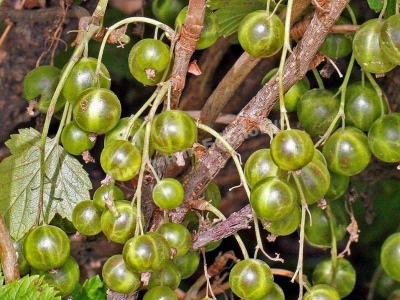
- Authors: T.V. Zhidekhina, O.S. Rodyukova, S.A. Magomedov, VNIIS them. I. V. Michurina
- Appeared when crossing: 13-5-146 (Ojebyn x Black Pearl)
- Ripening terms: medium late ripening
- Growth type: medium-sized
- Yield: high
- Appointment: universal
- Berry weight, g: 1,1-1,2
- Tasting assessment: 4,7
- Escapes: ligneous - thick and medium, straight, grayish, with a golden blush, shiny
- Sheet: five-lobed, large and medium, green, glabrous, slightly shiny
Along with the main species, there are also rare varieties of currants with multi-colored fruits. As paradoxical as it may sound, there is a black currant with green berries. This is the Emerald Necklace variety.
Breeding history
The unique green-fruited culture was the result of selection carried out by the specialists of the V.I. Michurin near Tambov. The leading breeders of the center T.V. Zhidekhina, O.S.Rodyukova, S.A.Magomedova worked on the new variety. They hybridized the Siberian subspecies Black Pearl with the Scandinavian blackcurrant subspecies Ojebyn, due to which the resulting berry turned green.
However, the goal was different - the creation of frost-resistant currants, which also have resistance to diseases and pests. But still, the idea related to color was also present. The breeders wanted to get a berry that does not have the allergenic properties of black currants.
All these tasks have been successfully solved by scientists. Since 2009, the variety has been under strain testing. According to research, the green berry is completely hypoallergenic.
Description of the variety
The bush of the described culture is erect, the height is 1.2 meters. Average spreading. Foliage of a delicate green color, with a slight sheen. The leaves are 5-lobed, the size can be both medium and large. The brushes are dense, drooping, from 6.5 to 10.2 cm, long and medium. The flowers are purple, goblet, small.
Characteristics of berries
Fruit color, unusual for currants, green-yellow. Transparent soft peel, there are gaps, small seeds. The size of the berries is large, weighing up to 1.2 g.
Taste qualities
The taste of the fruits of green currant is sweet and sour, the berries are aromatic. But the benefits of berries are not limited to this. They are also very useful as they contain many biologically active substances such as polyphenols and ascorbic acid. Green berries are a source of potassium and calcium, which are beneficial for cardiovascular diseases.
Ripening and fruiting
The culture is medium late in terms of ripening. Ripe berries are harvested in August.

Yield
The emerald necklace is a very fruitful variety. 9.6 tons of fruits are obtained from 1 hectare. And one bush brings 2.9 kg of the healthiest green berries.
Landing
Green-fruited currants need good lighting in the process of their growth.For planting, you need to choose a place that is open, the penetration of sunlight, while light shading is possible. However, in full shade, fruiting will deteriorate, the berries will not be so sweet. The ideal planting option is the southern corner of the garden, protected from wind and cold drafts.
Although the Emerald Necklace shows good frost resistance, in spring the cold air can damage the flowers. And also the absence of nearby groundwater is desirable. As for the soil, the culture prefers a slightly alkaline soil, and it should also be loose and fertile.
If several bushes of varietal currants are planted, the distance between them should be from 1.2 to 1.5 meters. Interestingly, a plant with green fruits will feel very good next to grapes, and it can also be planted under fruit trees: peaches, cherries and pears.
Planting is recommended in the fall. But if you manage to avoid frost, then you can plant it in the spring. However, then regular watering of young shrubs will be required during the first months.

Growing and care
One of the most important elements of caring for a varietal crop is proper watering. You need to water the culture quite often, especially the first couple of weeks after planting: 2-3 waterings in 7 days. To keep the soil moisture in the soil as long as possible, the foot of the bush should be mulched. And it is also necessary to regularly remove weeds, and it is advisable to do this manually. This is due to the fact that this currant has superficial roots, and it is easy to damage them with a hoe. In order for the air masses to circulate correctly, experts sometimes recommend piercing the soil next to the trunk with a pitchfork.





Currant is one of the most favorite crops of gardeners, it can be found on almost any personal plot. In order for the currant berries to be tasty and large, and the bush itself to be healthy and strong, you should properly care for, treat and protect the plant from harmful insects. It is important to recognize the signs of the disease in a timely manner and begin treatment in the early stages of plant damage.
Resistance to adverse climatic conditions
Emerald necklace is a very winter-hardy variety. Since the culture was developed specifically for regions where there are often severe winters, it does not require shelter.










































































